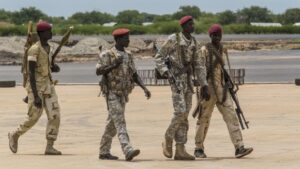As the US Air Force seeks to implement its Agile Combat Employment (ACE) strategy, the service faces a critical challenge: how to defend a growing network of smaller, more dispersed bases across the vast expanse of the Pacific.
This new ACE approach to military operations, designed to increase mobility and survivability, accordingly requires rethinking traditional defense methods.
To succeed, the Air Force (alongside the US Army) must collaborate to develop innovative, flexible, and cost-effective defense solutions capable of adapting to rapidly evolving threats.
For decades, the US military has relied on robust air defense systems like the revered PATRIOT air defense system and Terminal High Altitude Area Defense (THAAD) to protect its larger bases.
These systems are highly effective at countering advanced missile threats but come with significant logistical and financial challenges.
Deploying them across a network of smaller, remote outposts in the Pacific would be prohibitively expensive and impractical, undermining the very agility that the ACE strategy aims to achieve.
The reliance on these traditional, fixed systems is not feasible for the dispersed, rapidly deployable bases that the Air Force envisions under ACE.
To address these limitations, the US Air Force’s top officer, Gen. David Allvin, has highlighted the following ways for the joint military branches to defend these agile outposts:
As the US Air Force seeks to implement its Agile Combat Employment (ACE) strategy, the service faces a critical challenge: how to defend a growing network of smaller, more dispersed bases across the vast expanse of the Pacific.
This new ACE approach to military operations, designed to increase mobility and survivability, accordingly requires rethinking traditional defense methods.
To succeed, the Air Force (alongside the US Army) must collaborate to develop innovative, flexible, and cost-effective defense solutions capable of adapting to rapidly evolving threats.
For decades, the US military has relied on robust air defense systems like the revered PATRIOT air defense system and Terminal High Altitude Area Defense (THAAD) to protect its larger bases.
These systems are highly effective at countering advanced missile threats but come with significant logistical and financial challenges.
Deploying them across a network of smaller, remote outposts in the Pacific would be prohibitively expensive and impractical, undermining the very agility that the ACE strategy aims to achieve.
The reliance on these traditional, fixed systems is not feasible for the dispersed, rapidly deployable bases that the Air Force envisions under ACE.
To address these limitations, the US Air Force’s top officer, Gen. David Allvin, has highlighted the following ways for the joint military branches to defend these agile outposts:
The Need for Mobile and Cost-Effective Defense Solutions
The need for mobile and cost-effective defense solutions effort involves developing mobile defense systems that can be easily repositioned to counter threats wherever they may arise.
Flexibility is key; the ability to move these defenses quickly not only enhances survivability but also allows for more strategic deployment of resources.
Innovations such as mobile missile interceptors and directed energy weapons are being considered to provide a more adaptable defense posture.
These technologies promise to offer a cost-effective solution that can be scaled up or down depending on the threat level and operational requirements.
M901 Patriot Launching Station (DVIDS)
Adapting to Non-Kinetic Threats
Beyond traditional missile and air threats, the US must also prepare for an array of non-kinetic challenges in the modern battlefield.
Cyber attacks, electronic warfare, and other forms of non-kinetic aggression are becoming increasingly prevalent and can cripple a base’s ability to operate effectively.
Addressing these threats requires a multi-layered defense strategy integrating cyber defenses and electronic countermeasures alongside physical protection systems.
This comprehensive approach ensures that American bases in the Pacific are secure from traditional attacks and resilient against potential adversaries’ sophisticated cyber and electronic warfare tactics.
Soldiers during electronic countermeasures training. (DVIDS)
Enhancing Inter-Service Collaboration for Future Readiness
Central to this new defense strategy is the collaboration between the Air Force and the Army.
By working together, these branches can leverage their unique capabilities to develop solutions tailored to the specific needs of the ACE strategy.
This joint effort is not merely about sharing resources; it’s about creating a unified defense framework that maximizes each service’s strengths.
Successful inter-service initiatives, such as the development of mobile and flexible defense technologies, have already shown the potential of this approach.
Continuing to build on this collaboration will be vital for ensuring the effectiveness of US military operations in the region.
US Air Force F-16 Fighting Falcon (DVIDS)
The security landscape in the Indo-Pacific is rapidly evolving, with increasing competition and potential threats requiring a more agile and resilient US military presence.
The ACE strategy is a proactive response to this environment, aiming to ensure that the US can operate effectively across the region.
“If we can’t have them at every space, we want to be able to decide where to place them, which means they need to be mobile enough to be able not just to be fixed, and so that’s some of the cleverness that has to happen with this, as well as the ability to rapidly move,” Allvin told reporters last August 21. “The old school things of camouflage, concealment, and deception are still alive and well, we just need to upgrade them to a 21st Century context.”
However, achieving this vision will depend on innovating and adapting to new threats and technologies.
Continued investment in research and development is essential to maintaining the US’s strategic edge and ensuring that its forces are prepared for the challenges ahead.
US Air Force Chief of Staff Gen. David Allvin speaks during an all-call at Robins Air Force Base, Georgia, Aug. 13, 2024. (DVIDS)
Final Thoughts: The future of US military operations in the Pacific is all about being able to defend a network of flexible, spread-out bases.
To make this happen, the Air Force and Army are focusing on innovation and working closely together. They’re developing mobile defense systems and gearing up for all sorts of physical and digital threats.
As the Indo-Pacific becomes more competitive, it’s clear that America needs a military presence that’s both resilient and adaptable.
By staying on top of emerging challenges and investing in the latest technologies, the US is positioning itself to stay a strong force in the region for the long haul.
—
Disclaimer: SOFREP utilizes AI for image generation and article research. Occasionally, it’s like handing a chimpanzee the keys to your liquor cabinet. It’s not always perfect and if a mistake is made, we own up to it full stop. In a world where information comes at us in tidal waves, it is an important tool that helps us sift through the brass for live rounds.



